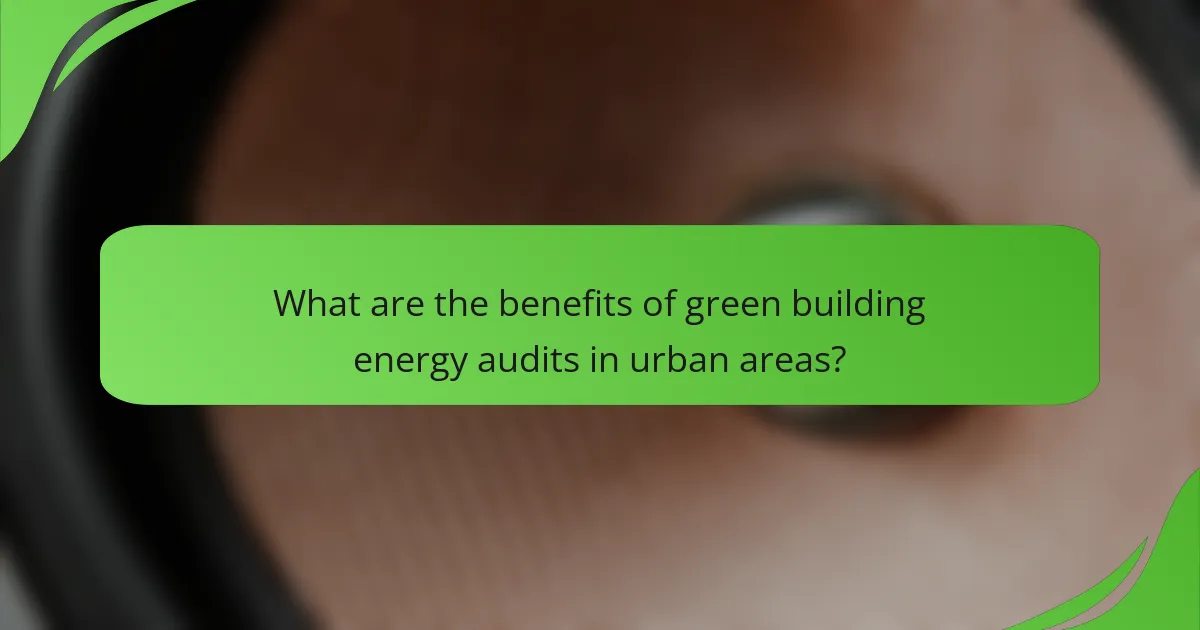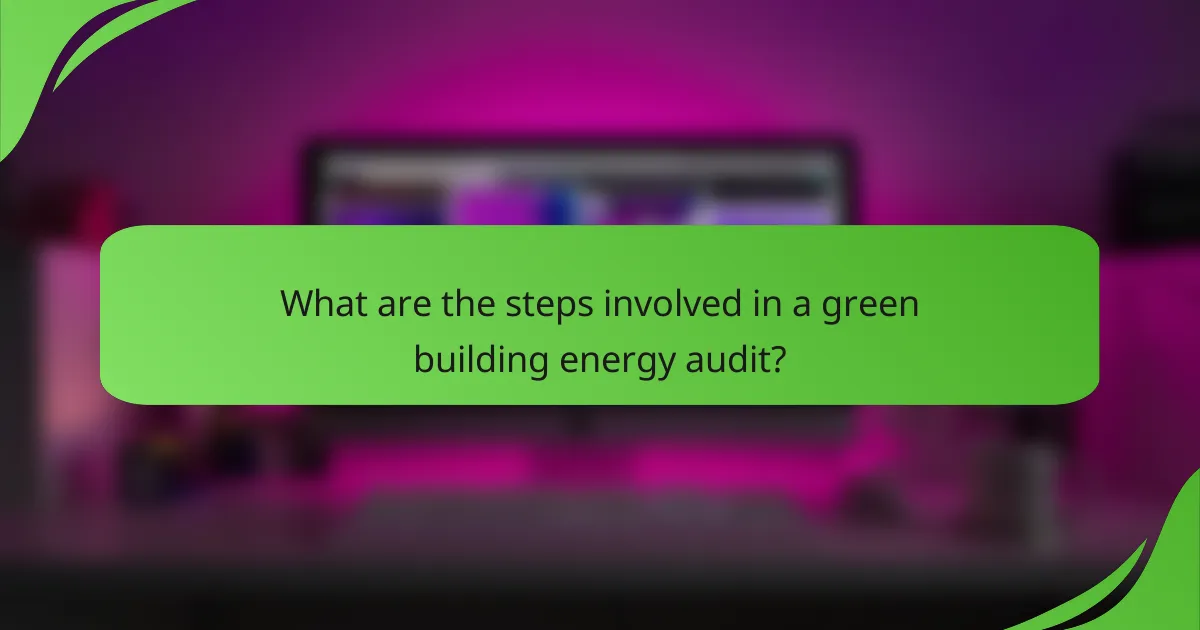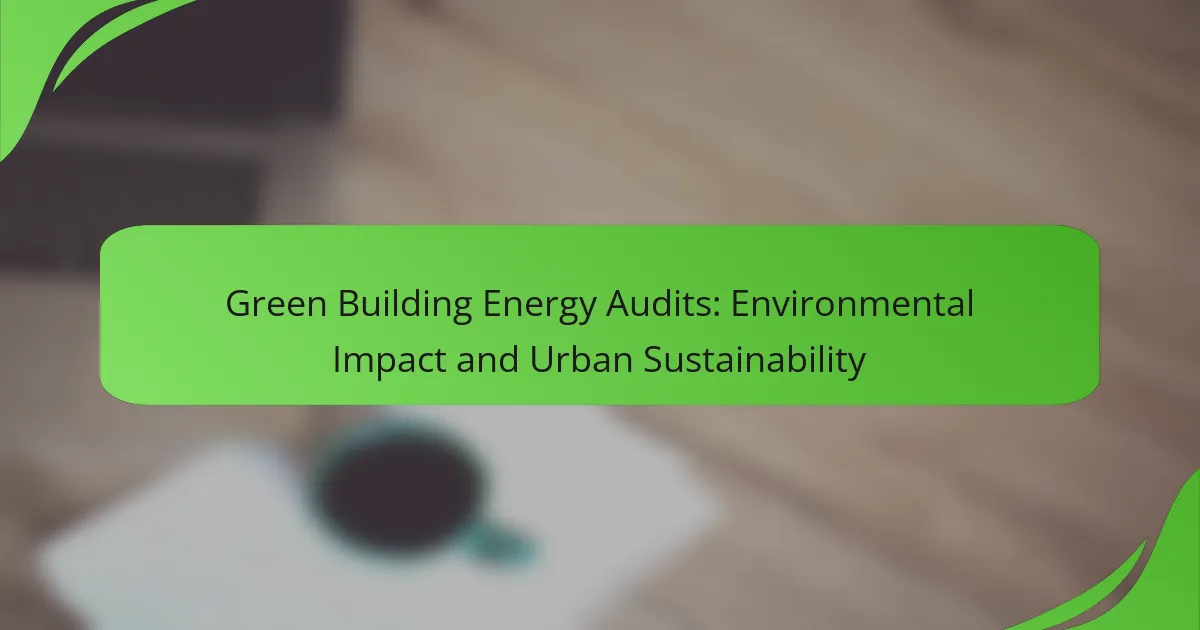Green building energy audits play a crucial role in enhancing urban sustainability by identifying inefficiencies in energy use and promoting environmentally friendly practices. By providing actionable recommendations, these audits not only reduce energy costs but also contribute to lower carbon footprints and improved occupant satisfaction. Through systematic evaluation, they pave the way for a more sustainable future in urban environments.

What are the benefits of green building energy audits in urban areas?
Green building energy audits in urban areas offer significant advantages, including reduced energy costs, improved environmental performance, and enhanced occupant satisfaction. These audits identify inefficiencies and provide actionable recommendations to optimize energy use and promote sustainability.
Reduced energy consumption
One of the primary benefits of green building energy audits is the reduction in energy consumption. By assessing current energy use and identifying inefficiencies, audits can lead to substantial savings on utility bills. Implementing recommended changes can often result in energy reductions of 20-30% or more.
Common strategies include upgrading insulation, installing energy-efficient lighting, and optimizing HVAC systems. These improvements not only lower energy costs but also contribute to a more sustainable urban environment.
Lower greenhouse gas emissions
Green building energy audits help in lowering greenhouse gas emissions by promoting energy efficiency. Reducing energy consumption directly correlates with decreased emissions from power plants, which are often fossil fuel-based. This is particularly crucial in urban areas where air quality can be significantly impacted by emissions.
For example, a building that reduces its energy use by 25% can significantly lower its carbon footprint, contributing to city-wide goals for emissions reduction and climate action. Many cities have set ambitious targets for reducing greenhouse gases, making these audits essential for compliance.
Improved indoor air quality
Energy audits can lead to improved indoor air quality by identifying sources of pollutants and recommending ventilation improvements. Proper ventilation systems can reduce the concentration of indoor contaminants, which is vital for occupant health and comfort.
By ensuring that buildings are well-ventilated and using low-emission materials, audits can help create healthier living and working environments. This is especially important in densely populated urban areas where indoor air quality can significantly affect public health.
Enhanced property value
Buildings that undergo green energy audits often see an increase in property value. Energy-efficient upgrades make properties more attractive to buyers and tenants, as they promise lower utility costs and a reduced environmental impact.
In many urban markets, properties with green certifications or energy-efficient features can command higher rents or sale prices. This trend reflects a growing awareness and preference for sustainable living among consumers.
Increased occupant comfort
Green building energy audits contribute to increased occupant comfort by ensuring optimal temperature control and air quality. By addressing issues such as drafts, humidity, and temperature fluctuations, audits help create a more pleasant indoor environment.
Comfortable spaces enhance productivity and well-being, making them particularly valuable in urban settings where people spend significant time indoors. Implementing energy-efficient measures can lead to a noticeable improvement in overall occupant satisfaction.

How do green building energy audits improve sustainability?
Green building energy audits enhance sustainability by identifying inefficiencies, recommending renewable energy sources, and promoting the use of sustainable materials. These audits help reduce energy consumption, lower carbon footprints, and improve overall environmental performance in urban settings.
Identifying energy inefficiencies
Energy audits pinpoint areas where buildings waste energy, such as outdated HVAC systems, poor insulation, or inefficient lighting. By assessing these inefficiencies, property owners can implement targeted upgrades that significantly reduce energy use.
Common methods include thermal imaging to detect heat loss and analyzing utility bills to identify unusual spikes in energy consumption. Addressing these inefficiencies can lead to energy savings of 20-30%, making a substantial impact on both costs and environmental sustainability.
Recommending renewable energy sources
Energy audits often suggest integrating renewable energy sources like solar panels or wind turbines to offset traditional energy use. These recommendations are tailored to the building’s location, available space, and energy needs, ensuring effective implementation.
For instance, a building in a sunny area might benefit from solar photovoltaic systems, which can cover a significant portion of energy demand. Transitioning to renewable sources not only reduces reliance on fossil fuels but can also lead to long-term cost savings and potential tax incentives.
Promoting sustainable materials
Audits encourage the use of sustainable materials in renovations and new constructions, which can minimize environmental impact. This includes selecting materials that are recycled, locally sourced, or have low embodied energy.
For example, using bamboo flooring or reclaimed wood can significantly reduce the carbon footprint of a building project. Additionally, sustainable materials often improve indoor air quality, contributing to healthier living and working environments.

What are the steps involved in a green building energy audit?
A green building energy audit involves a systematic evaluation of a building’s energy use to identify opportunities for improvement and sustainability. The process typically includes initial consultations, data collection, analysis, and the formulation of actionable recommendations.
Initial consultation and site assessment
The first step in a green building energy audit is an initial consultation, where auditors meet with building owners to understand their goals and concerns. This is followed by a site assessment, which involves a walkthrough of the building to observe its systems, layout, and usage patterns.
During the site assessment, auditors check for energy inefficiencies, such as outdated HVAC systems, poor insulation, and lighting issues. This phase sets the foundation for the data collection and analysis that will follow.
Data collection and analysis
Data collection involves gathering information on energy consumption, building materials, and operational practices. This can include utility bills, equipment specifications, and occupancy schedules. Auditors may also use tools like thermal imaging cameras to identify heat loss areas.
Once data is collected, auditors analyze it to pinpoint inefficiencies and calculate potential energy savings. This analysis helps in understanding how different systems interact and where improvements can yield the highest returns.
Reporting and recommendations
The final step is to compile findings into a comprehensive report that outlines the audit results. This report typically includes a summary of energy usage, identified issues, and specific recommendations for improvements.
Recommendations may range from simple measures, like switching to LED lighting, to more extensive upgrades, such as installing solar panels or enhancing insulation. The report often prioritizes actions based on cost-effectiveness and potential energy savings, guiding building owners toward sustainable practices.

What tools are used for green building energy audits?
Green building energy audits utilize various tools to assess energy efficiency and identify areas for improvement. These tools help in analyzing energy consumption patterns, detecting inefficiencies, and recommending solutions to enhance sustainability.
Energy modeling software
Energy modeling software simulates a building’s energy performance under different scenarios. It allows auditors to input design specifications, occupancy patterns, and local climate data to predict energy use and costs over time.
Common software options include EnergyPlus, eQUEST, and TRACE 700. When selecting software, consider factors like ease of use, compatibility with local building codes, and the ability to generate detailed reports for stakeholders.
Infrared thermography cameras
Infrared thermography cameras detect heat loss and moisture issues in building envelopes by visualizing temperature differences. These cameras can identify insulation gaps, air leaks, and thermal bridging, which are critical for improving energy efficiency.
When using infrared cameras, ensure proper calibration and consider the time of day, as temperature variations can affect readings. Regular maintenance of the equipment is also essential for accurate results.
Blower door tests
Blower door tests measure a building’s airtightness by creating a pressure difference between the inside and outside. This test helps identify air leaks that can lead to energy loss and discomfort for occupants.
During the test, a fan is mounted in an exterior doorway to depressurize the building. The resulting airflow is measured to determine the air changes per hour (ACH). Aim for an ACH value that meets or exceeds local energy efficiency standards to ensure optimal performance.

What certifications can green building energy audits achieve?
Green building energy audits can lead to several recognized certifications that demonstrate a building’s sustainability and energy efficiency. These certifications not only enhance the building’s marketability but also contribute to environmental conservation and urban sustainability.
LEED certification
LEED (Leadership in Energy and Environmental Design) certification is one of the most widely recognized green building standards globally. It evaluates buildings based on various criteria, including energy efficiency, water usage, and indoor environmental quality.
To achieve LEED certification, a building must earn points across several categories, with a minimum threshold required for certification. There are different levels of certification, such as Certified, Silver, Gold, and Platinum, depending on the total points accumulated.
BREEAM certification
BREEAM (Building Research Establishment Environmental Assessment Method) is a leading sustainability assessment method for master planning projects, infrastructure, and buildings. It focuses on sustainable value and encourages the use of sustainable materials and practices.
To obtain BREEAM certification, a project must meet specific performance benchmarks across categories like energy, water, and materials. Similar to LEED, BREEAM offers different ratings, including Pass, Good, Very Good, Excellent, and Outstanding, based on the points achieved.
Energy Star certification
Energy Star certification is a program run by the U.S. Environmental Protection Agency (EPA) that identifies buildings and products that are energy efficient. Buildings that earn this certification typically use 20-30% less energy than similar buildings, leading to lower energy costs and reduced greenhouse gas emissions.
To qualify for Energy Star certification, a building must meet specific energy performance benchmarks and undergo a rigorous evaluation process. This certification is particularly beneficial for commercial buildings looking to improve their energy efficiency and appeal to environmentally conscious tenants.

What are the costs associated with green building energy audits?
The costs of green building energy audits can vary significantly based on factors such as location, building size, and the depth of the audit. Generally, these audits can range from a few hundred to several thousand dollars, depending on the complexity of the assessment and the specific services included.
Average audit costs in major cities
In major cities, the average costs for green building energy audits typically fall between $1,000 and $5,000. For instance, in New York City, comprehensive audits may reach the higher end of this range due to increased demand and regulatory requirements.
In contrast, cities like Atlanta or Denver might offer audits at lower costs, often starting around $800, reflecting differences in local market conditions and competition among service providers. It’s essential to compare quotes from multiple auditors to ensure you receive a fair price.
Additionally, consider the potential savings from implementing recommendations from the audit. While the upfront cost may seem high, energy savings and potential rebates can offset these expenses over time, making it a worthwhile investment for sustainability-focused buildings.
